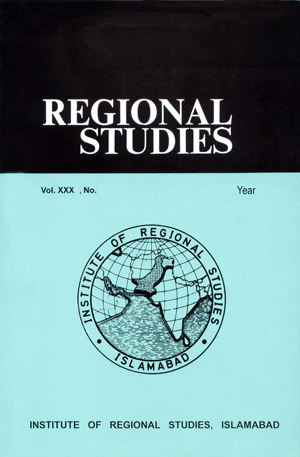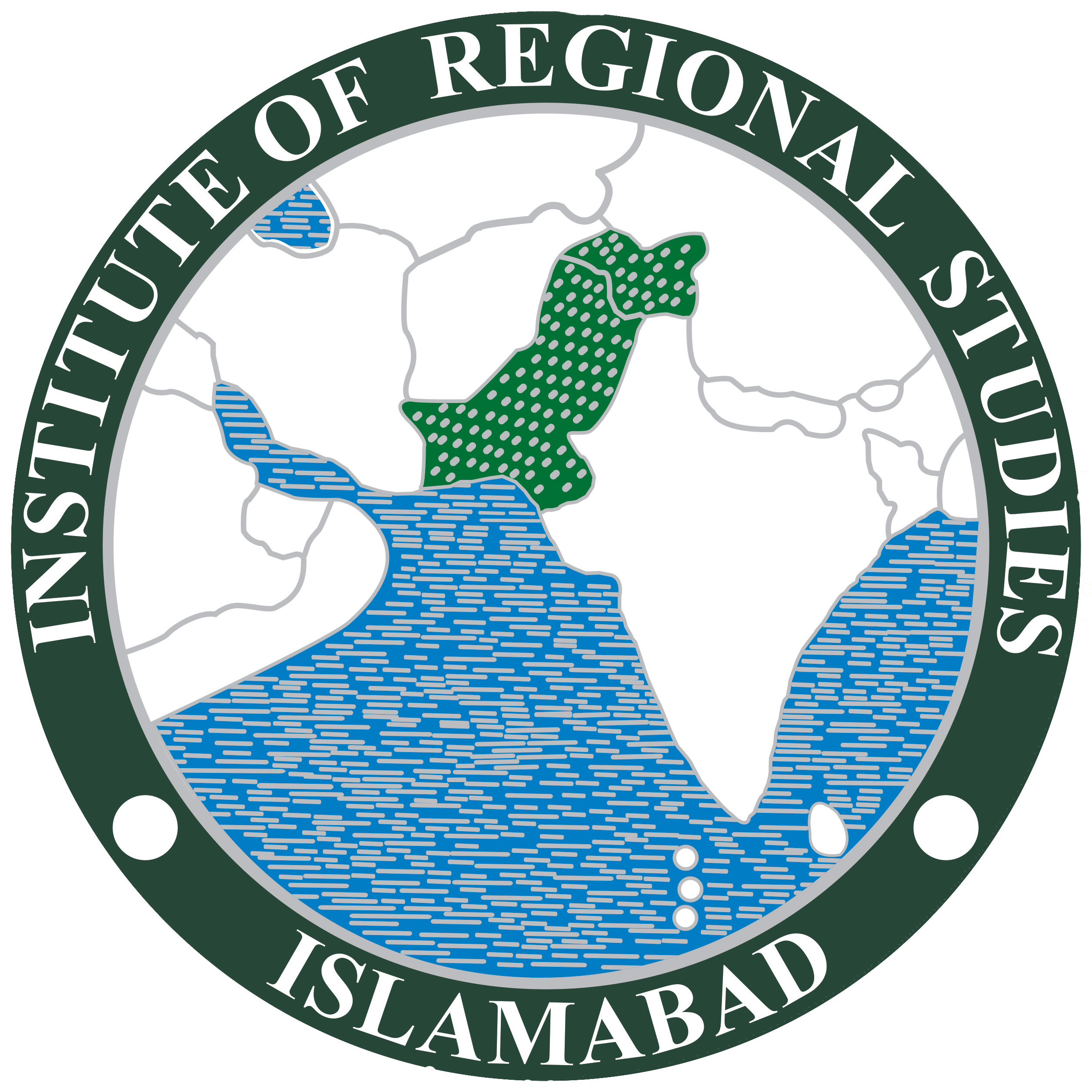Regional Studies

Regional Studies is a quarterly journal. It covers a wide spectrum including foreign and internal affairs, economy and industry, science and technology, sociocultural aspects and security related issues. The countries that fall within the purview of the study are India, Pakistan, Bangladesh, Sri Lanka, Nepal, Maldives in South Asia, Afghanistan, Iran and the Gulf States in Southwest Asia and five republics of Central Asia, beside China and Indian Ocean.
Editor's Note
Scholars who have an interest in the regional affairs are invited to contribute to the IRS journal.Submission Guidelines
Aarish U. Khan
Editor
Email: editorirs@gmail.com
Families and Political Recruitment in Minor Political Parties in Bangladesh
Md. Bakthear Uddin Political dynasties play an important role in several modern states. There has been a remarkable increase in the role of families in political parties and politics not only in Bangladesh but also in the whole world. No country in South Asia is immune from the dominance of families in politics. Bangladesh is not an exception in this regard. More or less, each and every political party has a dynastic leadership. Families play a role in leadership recruitment not only in the major parties but also in the minor ones in Bangladesh. This paper assesses the role of families in leadership recruitment in the minor parties in Bangladesh. An attempt has been made here to give a description of recruitment of leaders of some minor parties in Bangladesh from the members of the families of the powerful leaders of those parties. This paper claims that control by families of most minor parties has its material, psychological, and anthropological roots as these parties are primarily an extended clan of the principal leader of these parties.
Political dynasties play an important role in several modern states. There has been a remarkable increase in the role of families in political parties and politics not only in Bangladesh but also in the whole world. No country in South Asia is immune from the dominance of families in politics. Bangladesh is not an exception in this regard. More or less, each and every political party has a dynastic leadership. Families play a role in leadership recruitment not only in the major parties but also in the minor ones in Bangladesh. This paper assesses the role of families in leadership recruitment in the minor parties in Bangladesh. An attempt has been made here to give a description of recruitment of leaders of some minor parties in Bangladesh from the members of the families of the powerful leaders of those parties. This paper claims that control by families of most minor parties has its material, psychological, and anthropological roots as these parties are primarily an extended clan of the principal leader of these parties.
GEOPOLITICS OF RCEP AND SINO-AMERICAN COMPETITION IN THE ASIA-PACIFIC
FURQAN KHANBANGLADESH-CHINA ECONOMIC RELATIONS: INVESTMENT, PROJECTS, AND PARTNERSHIPS
MOHAMMAD JAHIRUL QUIYUM In recent years, Bangladesh-China economic relation has emerged as a strong and mutually beneficial relationship due to steady development. Bangladesh and China have expanded their economic cooperation in infrastructure, transportation and communication, information technology, power, maritime, and other sectors. Chinese investment, assistance, and cooperation are being carried out on the basis of equality, mutual benefit, and economic development. Both Bangladesh and China are trying to develop and employ innovative ideas for increasing economic engagement. As a result of this, it is expected that in the near future Bangladesh-China economic relation is going to emerge as an obligatory part for each other’s economic development. To ensure mutual and faster economic development, both sides are giving importance to economic investment, projects, and partnerships. In the process, several potential sectors have been identified which can play an important role in increasing investment as well as for engaging in new projects. This paper gives a descriptive view of Chinese investments, projects, and partnership on the economy of Bangladesh and at the same time assesses the scope and prospect of Chinese investment, projects, and partnerships in recent years.
In recent years, Bangladesh-China economic relation has emerged as a strong and mutually beneficial relationship due to steady development. Bangladesh and China have expanded their economic cooperation in infrastructure, transportation and communication, information technology, power, maritime, and other sectors. Chinese investment, assistance, and cooperation are being carried out on the basis of equality, mutual benefit, and economic development. Both Bangladesh and China are trying to develop and employ innovative ideas for increasing economic engagement. As a result of this, it is expected that in the near future Bangladesh-China economic relation is going to emerge as an obligatory part for each other’s economic development. To ensure mutual and faster economic development, both sides are giving importance to economic investment, projects, and partnerships. In the process, several potential sectors have been identified which can play an important role in increasing investment as well as for engaging in new projects. This paper gives a descriptive view of Chinese investments, projects, and partnership on the economy of Bangladesh and at the same time assesses the scope and prospect of Chinese investment, projects, and partnerships in recent years.
PAKISTAN’S BLUE ECONOMY AMID INCREASING MILITARISATION IN THE INDIAN OCEAN
WASIM SAJJAD This study focuses on the potential of ‘blue economy’ for Pakistan given its unique geography and considerable coastline with resources like fish, islands, beaches, ports, etc. Pakistan has yet to fully tap the economic potential of its maritime resources. Among various causes of the under-utilisation of the land and maritime connectivity for the country’s economic development are the regional fault-lines, i.e., Kashmir and Afghanistan, and power competition in the Indian Ocean, which impacts developing countries like Pakistan. The bilateral trade between India and Pakistan is the lowest among all the South Asian countries whereas both countries spend huge amounts on defence procurement from extra-regional countries. The strategic triangle between India, China, and Pakistan and growing alliances in the Indian Ocean Region (IOR) also have a significant impact on the prospects of the ‘blue economy’ for Pakistan. Due to its security-centric foreign policy, Islamabad missed many economic opportunities. If developed sustainably, the country’s blue industry has the potential to strengthen and stabilise the economy by creating an enormous amount of trade and employment opportunities not only for Pakistan but also for neighbours and landlocked Central Asia and Afghanistan.
This study focuses on the potential of ‘blue economy’ for Pakistan given its unique geography and considerable coastline with resources like fish, islands, beaches, ports, etc. Pakistan has yet to fully tap the economic potential of its maritime resources. Among various causes of the under-utilisation of the land and maritime connectivity for the country’s economic development are the regional fault-lines, i.e., Kashmir and Afghanistan, and power competition in the Indian Ocean, which impacts developing countries like Pakistan. The bilateral trade between India and Pakistan is the lowest among all the South Asian countries whereas both countries spend huge amounts on defence procurement from extra-regional countries. The strategic triangle between India, China, and Pakistan and growing alliances in the Indian Ocean Region (IOR) also have a significant impact on the prospects of the ‘blue economy’ for Pakistan. Due to its security-centric foreign policy, Islamabad missed many economic opportunities. If developed sustainably, the country’s blue industry has the potential to strengthen and stabilise the economy by creating an enormous amount of trade and employment opportunities not only for Pakistan but also for neighbours and landlocked Central Asia and Afghanistan.
TRADE DEFICIT WITH CHINA: REALISING GAINS FOR PAKISTAN
ALI HAIDER SALEEM
